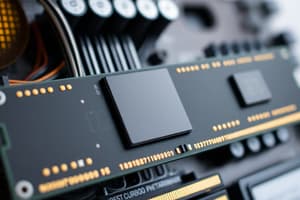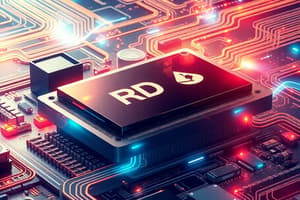Podcast
Questions and Answers
Match the following cooling methods with their primary function:
Match the following cooling methods with their primary function:
Heat Sink = Transfers heat away from components Fan = Dissipates heat by circulating air Liquid Cooling = Uses a coolant to absorb and transfer heat Thermal Paste = Improves heat transfer between components
Match the following types of RAM with their characteristic:
Match the following types of RAM with their characteristic:
DDR4 = Lower power consumption and faster transfer rates DDR5 = Improved bandwidth and higher module density SDRAM = Synchronized with the system bus for faster speeds ECC RAM = Detects and corrects data errors
Match the following motherboard form factors with their typical use cases:
Match the following motherboard form factors with their typical use cases:
ATX = Standard desktop computers requiring multiple expansion slots Micro-ATX = Compact systems with fewer expansion possibilities Mini-ITX = Small form factor builds and home theater PCs E-ATX = High-end gaming and workstation systems
Match the following types of output devices with their primary function:
Match the following types of output devices with their primary function:
Match the following storage devices with their technology:
Match the following storage devices with their technology:
Match the following CPU components with their function:
Match the following CPU components with their function:
Match the following GPU components with their typical function:
Match the following GPU components with their typical function:
Match the following power supply certifications with their efficiency level:
Match the following power supply certifications with their efficiency level:
Match the following input devices with their common usages:
Match the following input devices with their common usages:
Match the following expansion cards with their typical functions:
Match the following expansion cards with their typical functions:
Match the following types of computer cases with their advantages:
Match the following types of computer cases with their advantages:
Match the following CPU terms with their descriptions:
Match the following CPU terms with their descriptions:
Match the interface types with their associated storage devices:
Match the interface types with their associated storage devices:
Match the port types with their connecting devices:
Match the port types with their connecting devices:
Match the following case features with their benefits:
Match the following case features with their benefits:
Match the following memory concepts with their functions:
Match the following memory concepts with their functions:
Match the PSU wattage requirements with their corresponding system setups:
Match the PSU wattage requirements with their corresponding system setups:
Match the following storage considerations with their effects:
Match the following storage considerations with their effects:
Match the wireless standards with their data transfer rates:
Match the wireless standards with their data transfer rates:
Flashcards
Hardware Components
Hardware Components
The physical parts of a computer system, essential for its operation. Includes internal and external parts.
Central Processing Unit (CPU)
Central Processing Unit (CPU)
The 'brain' of the computer that executes instructions and performs calculations.
Control Unit
Control Unit
Part of the CPU that fetches, decodes, and executes instructions.
Arithmetic Logic Unit (ALU)
Arithmetic Logic Unit (ALU)
Signup and view all the flashcards
Registers (in CPU)
Registers (in CPU)
Signup and view all the flashcards
Random Access Memory (RAM)
Random Access Memory (RAM)
Signup and view all the flashcards
Storage Devices
Storage Devices
Signup and view all the flashcards
Hard Disk Drive (HDD)
Hard Disk Drive (HDD)
Signup and view all the flashcards
Solid State Drive (SSD)
Solid State Drive (SSD)
Signup and view all the flashcards
Motherboard
Motherboard
Signup and view all the flashcards
Graphics Processing Unit (GPU)
Graphics Processing Unit (GPU)
Signup and view all the flashcards
Power Supply Unit (PSU)
Power Supply Unit (PSU)
Signup and view all the flashcards
Input Devices
Input Devices
Signup and view all the flashcards
Output Devices
Output Devices
Signup and view all the flashcards
Cooling Systems
Cooling Systems
Signup and view all the flashcards
Expansion Cards
Expansion Cards
Signup and view all the flashcards
Computer Cases
Computer Cases
Signup and view all the flashcards
Study Notes
- Hardware components are the physical parts of a computer system
- These components are essential for the computer to function
- Hardware includes both internal and external parts
Central Processing Unit (CPU)
- The CPU is the brain of the computer
- It executes instructions and performs calculations
- CPU speed is measured in GHz (gigahertz)
- Key manufacturers include Intel and AMD
- The CPU consists of the control unit, arithmetic logic unit (ALU), and registers
- The control unit fetches, decodes, and executes instructions
- The ALU performs arithmetic and logical operations
- Registers are small, high-speed storage locations used to hold data and instructions
Memory (RAM)
- RAM is Random Access Memory
- RAM is used for temporary storage of data and instructions that the CPU is actively using
- RAM is volatile memory; data is lost when power is turned off
- RAM speed and capacity significantly impact system performance
- RAM capacity is measured in GB (gigabytes)
- Types of RAM include DDR4 and DDR5 (double data rate)
- Faster RAM speeds result in quicker data access and improved performance
Storage Devices
- Storage devices are used for long-term storage of data
- Unlike RAM, storage devices retain data even when the power is off (non-volatile)
- Common types include Hard Disk Drives (HDDs) and Solid State Drives (SSDs)
- HDDs store data on magnetic platters
- HDDs have moving parts and are slower compared to SSDs
- HDD capacity is measured in TB (terabytes)
- SSDs use flash memory to store data
- SSDs have no moving parts, resulting in faster access times and greater durability
- NVMe (Non-Volatile Memory Express) SSDs provide even faster speeds by utilizing the PCIe interface
- Optical drives like DVD and Blu-ray drives are also storage devices, but less commonly used now
Motherboard
- The motherboard is the main circuit board of the computer
- It connects all the components together
- It provides slots and connectors for the CPU, RAM, storage devices, and expansion cards
- Chipset on the motherboard controls communication between the CPU and other components
- Form factors like ATX and Mini-ITX determine the size and layout of the motherboard
- The motherboard includes various ports for connecting peripherals
Graphics Card (GPU)
- The GPU (Graphics Processing Unit) is responsible for rendering images and video
- It is essential for gaming, video editing, and other graphically intensive tasks
- GPUs have their own memory (VRAM)
- GPUs can be integrated into the CPU or discrete (separate card)
- Key manufacturers include NVIDIA and AMD
- GPU performance is measured by clock speed and memory capacity
Power Supply Unit (PSU)
- The PSU provides power to all the components in the computer
- It converts AC power from the wall outlet to DC power
- PSU wattage must be sufficient to handle the power requirements of all components
- 80+ certification indicates energy efficiency
- Modular PSUs allow for detachable cables
Input Devices
- Input devices allow users to enter data into the computer
- Common input devices include keyboards, mice, and touchscreens
- Keyboards are used for typing text
- Mice are used for navigation and selection
- Touchscreens allow direct interaction with the display
Output Devices
- Output devices display or present data from the computer to the user
- Common output devices include monitors, printers, and speakers
- Monitors display visual information
- Printers produce hard copies of documents
- Speakers output audio
Cooling Systems
- Cooling systems are used to dissipate heat generated by components like the CPU and GPU
- Overheating can cause performance issues and damage components
- Common cooling methods include fans, heat sinks, and liquid cooling
- Heat sinks are metal blocks that absorb heat
- Fans move air to dissipate heat from heat sinks
- Liquid cooling systems use a liquid coolant to transfer heat away from components
Expansion Cards
- Expansion cards add extra functionality to the computer
- Examples include network cards, sound cards, and video capture cards
- Expansion cards are installed in expansion slots on the motherboard (e.g., PCIe slots)
- Network cards enable the computer to connect to a network
- Sound cards improve audio quality
- Video capture cards allow recording video from external sources
Cases
- Computer cases house and protect the internal components
- Cases come in various sizes and designs
- Form factors (e.g., ATX, Mini-ITX) determine the size of the motherboard that can be installed
- Cases provide airflow for cooling
- Cases have front panel connectors for USB, audio, and power buttons
Studying That Suits You
Use AI to generate personalized quizzes and flashcards to suit your learning preferences.




